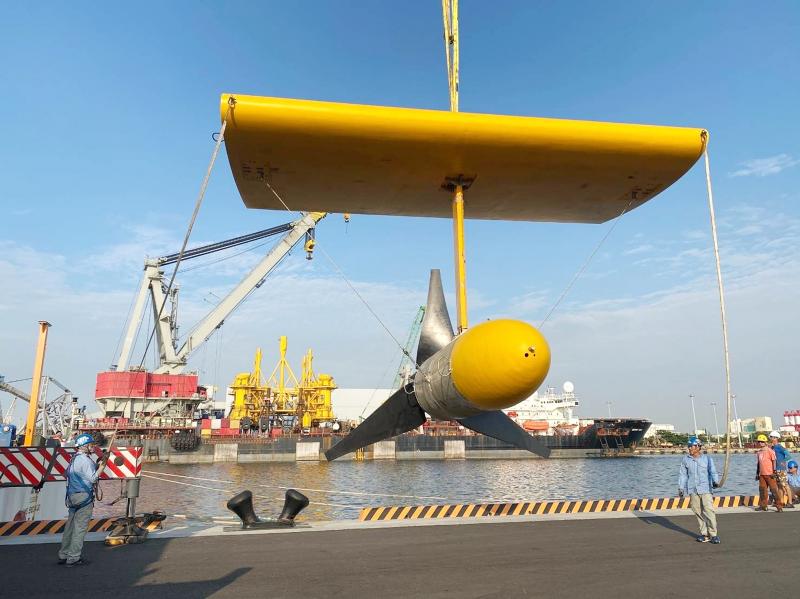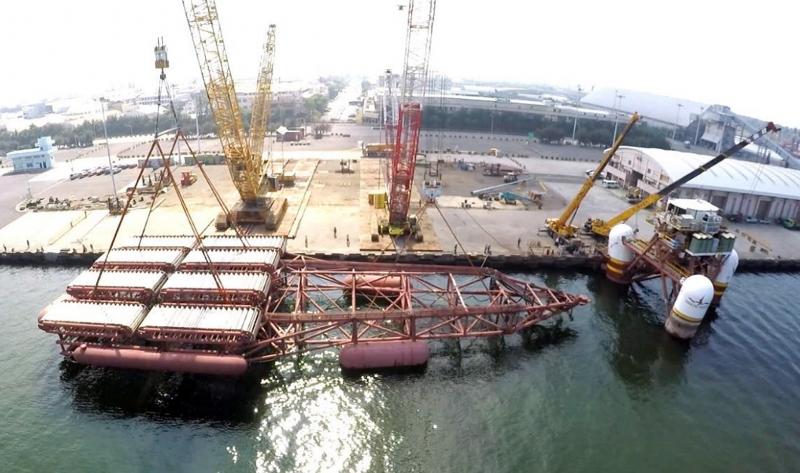The ocean is forever in motion. Waves lap or crash against the shore. Tides ebb and flow. Horizontal and vertical currents circulate nutrients and transfer heat from the tropics to polar regions.
Humanity has been trying to harness the sea’s energy for at least 1,400 years. The ruins of one tide-powered mill — discovered at the site of a former monastery in Northern Ireland and thought to have been used to dehusk grain and make flour — have been dated to AD 619-621.
In recent decades, scientists and engineers have been devising and testing hardware that can convert tidal and ocean-current energy into electricity. They’ve had a few successes.

Photo courtesy of Kuo Chen-hua
Completed in 1966, the Rance Tidal Power Station, a 750m-long barrage across a river estuary in northern France, produces enough electricity each year to meet the needs of approximately 90,000 local households.
At Strangford Lough, just a few kilometers from where those seventh-century Christian monks operated their tidal mill, what’s described as “the world’s first commercial tidal stream energy generator” has been supplying clean electricity to the Northern Irish grid since 2008.
The plant’s two 600kW turbines produce electricity for 18 to 20 hours per day as tides rise and fall. Because there’s no barrage, the environmental and aesthetic impact has been minimal. The Rance plant, by contrast, has caused siltation and, it’s claimed, the disappearance of certain fish and eel species.

Photo: Hung Ting-hung, Taipei Times
Due to the shape of Strangford Lough, tidal flows sometimes reach 4m per second. Despite the speed of the water, the turbines’ rotors turn slowly, and thus pose little danger to the seals, porpoises and other creatures that inhabit the lough. Water is 832 times denser than air, so tidal turbines can be much smaller than wind turbines yet produce just as much power.
TIDAL POWER
Unlike power stations that burn fossil fuels, tidal-power facilities cannot be fired up whenever electricity demand peaks. Yet they have one distinct advantage over some other renewables. Unlike sunshine and wind, tides can be perfectly predicted.

Photo: Lin Hsin-han, Taipei Times
Given the pressure on Taiwan and other industrialized economies to decarbonize, the government’s commitment to phase out nuclear power by 2025, and its 1,600-plus km of coastline, tidal power might seem like an obvious alternative for the country.
Unfortunately, Taiwan has very few bays or fjords suitable for tidal power plants, and weather patterns rule out the construction of Rance-type barrages across estuaries. Typhoons often wash huge amounts of debris down local creeks and rivers. (This, along with the seasonality of local waterways, is why run-of-the-river hydroelectricity has never made a significant contribution to Taiwan’s energy mix; typhoons would also endanger any wave energy converters close to the country’s shores.)
Even if a barrage could survive such an event, the amount of silt backed up behind it might permanently reduce its capacity to generate power, and perhaps lead to the river bursting its banks.

Photo: Lin Ching-lun, Taipei Times
Kehr Young-zehr (柯永澤), a professor emeritus in National Taiwan Ocean University’s Department of Systems Engineering & Naval Architecture, adds two considerations to the list of reasons why tidal power generation has yet to make its debut on Taiwan’s shoreline.
At some potential sites, including Fuguei Cape (富貴角) in New Taipei City and certain spots in Penghu County, the water is quite shallow.
“In these places, tidal power systems may not therefore survive if a typhoon hits,” Kehr says.
What’s more, he points out, tidal flow speeds in Taiwan generally don’t reach the 2.7m per second regarded as the minimum for a project to be economically viable.
OCEAN-CURRENT ENERGY
In view of these disadvantages, it isn’t surprising that Kehr has devoted part of his career to researching issues that surround a different form of green energy. Like many others in Taiwan and overseas, he believes that turbines positioned to take advantage of ocean currents could one day supply a meaningful amount of electricity.
According to Kehr, the locations which show the greatest potential for ocean-current energy are to the northwest of Green Island (綠島) and near Yilan County.
“The water depth at these two areas is about 200m, so installation wouldn’t be very difficult. What’s more, the current’s speed can reach 1.45m per second,” he says.
Because the speed of a particular current tends to be very stable, ocean-current power plants can be relied on to supply base load, Kehr says.
Elsewhere, he explains, the south-to-north Kuroshio Current moves at about 1m per second, and the sea is around 1,000m deep. In addition to being technically very challenging, such locations are unlikely to make economic sense.
Ocean-current turbine designs can include wings which generate lift, allowing operators to easily adjust the height. “The impact of a typhoon on a power plant won’t be serious if it’s 40m down in the sea,” says Kehr.
Surplus energy produced by ocean-current power plants could be stored in the form of hydrogen, he adds
A pilot project in the sea near Green Island — backed by the Ministry of Science and Technology and overseen by scientists from the National Academy of Marine Research and National Sun Yat-sen University (NSYSU) — was expanded earlier this year from 50kW to 400kW. (By comparison, a rooftop photovoltaic array comprising 32 modules is around 9kW.)
Kaohsiung-based Wanchi Steel Industrial Co is the principal commercial partner. According to Wanchi’s Web site, the project’s eight turbines (each 13m long and 5m wide) are now being tested for performance, durability, and survivability.
In a Jan. 14, 2021 report on the project’s progress, the Liberty Times (the sister paper of the Taipei Times) quoted Chen Yang-yih (陳陽益), former deputy minister of the Executive Yuan’s Ocean Affairs Council and now a professor at NSYSU, as saying that if 10 commercially-viable ocean-current systems, each of 2mW, can be developed, Green Island’s year-round electricity needs can be met. The island’s diesel-fired power station could then be decommissioned.
As for the environmental impact of ocean-current power plants, Kehr says, “Rotation speeds of large-diameter turbines are as slow as wind turbines, yet it’s difficult to judge if they’re dangerous to sea creatures. Construction work will certainly upset seabed ecosystems.”
Because there aren’t many potential sites for ocean-current power stations, Kehr believes it’ll be difficult for Taiwan to build a sizable industry and enjoy the economies of scale that have made solar power and offshore windfarms attractive to investors.
Moreover, he says, the field includes some research disciplines that Taiwan lacks, for example deep-sea mooring systems.
In 2013, Kehr told Taiwan Review, that progress in the field would be smooth if the government continued to fund research.
He still asserts that official support is the key to success: “Taiwan’s government doesn’t provide much support. Otherwise, they’d eliminate all the legal issues, like they’ve done for offshore windfarms.”
Steven Crook, the author or co-author of four books about Taiwan, has been following environmental issues since he arrived in the country in 1991. He drives a hybrid and carries his own chopsticks. The views expressed here are his own.

This month the government ordered a one-year block of Xiaohongshu (小紅書) or Rednote, a Chinese social media platform with more than 3 million users in Taiwan. The government pointed to widespread fraud activity on the platform, along with cybersecurity failures. Officials said that they had reached out to the company and asked it to change. However, they received no response. The pro-China parties, the Chinese Nationalist Party (KMT) and Taiwan People’s Party (TPP), immediately swung into action, denouncing the ban as an attack on free speech. This “free speech” claim was then echoed by the People’s Republic of China (PRC),

Exceptions to the rule are sometimes revealing. For a brief few years, there was an emerging ideological split between the Democratic Progressive Party (DPP) and Chinese Nationalist Party (KMT) that appeared to be pushing the DPP in a direction that would be considered more liberal, and the KMT more conservative. In the previous column, “The KMT-DPP’s bureaucrat-led developmental state” (Dec. 11, page 12), we examined how Taiwan’s democratic system developed, and how both the two main parties largely accepted a similar consensus on how Taiwan should be run domestically and did not split along the left-right lines more familiar in

As I finally slid into the warm embrace of the hot, clifftop pool, it was a serene moment of reflection. The sound of the river reflected off the cave walls, the white of our camping lights reflected off the dark, shimmering surface of the water, and I reflected on how fortunate I was to be here. After all, the beautiful walk through narrow canyons that had brought us here had been inaccessible for five years — and will be again soon. The day had started at the Huisun Forest Area (惠蓀林場), at the end of Nantou County Route 80, north and east

Specialty sandwiches loaded with the contents of an entire charcuterie board, overflowing with sauces, creams and all manner of creative add-ons, is perhaps one of the biggest global food trends of this year. From London to New York, lines form down the block for mortadella, burrata, pistachio and more stuffed between slices of fresh sourdough, rye or focaccia. To try the trend in Taipei, Munchies Mafia is for sure the spot — could this be the best sandwich in town? Carlos from Spain and Sergio from Mexico opened this spot just seven months ago. The two met working in the